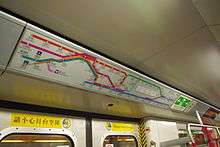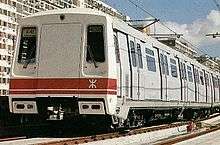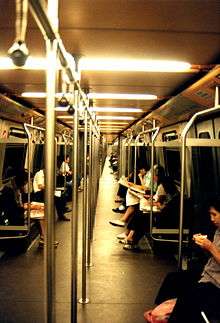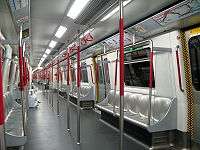MTR Metro Cammell EMU (DC)
| Metro-Cammell EMU (M-Train) CM/CT/I/G/H/Q stock
| |||||
|---|---|---|---|---|---|
| In service | 1 October 1973-2026 (Tsuen Wan line, Island line, Kwun Tong line, Tseung Kwan O line) | ||||
| Manufacturer | Metro Cammell, GEC Alstom | ||||
| Built at | Washwood Heath, Birmingham, England | ||||
| Replaced | Expected to be replaced between 2021 and 2026. | ||||
| Constructed | 1970-1988 | ||||
| Entered service | 1973-1983 (Phase 1 & 2), 1988-1989 (Phase 3) | ||||
| Refurbishment | United Goninan (1998-2001) | ||||
| Scrapped | Remaining all from 2021 onwards | ||||
| Number built | 760 cars | ||||
| Number in service | All | ||||
| Number scrapped | Starting from 2021 | ||||
| Formation | 8 cars per trainset (4 and 6 cars formation at initial service) (Local) | ||||
| Fleet numbers | Axxx, Bxxx, Cxxx, Dxxx, Pxxx, Qxxx | ||||
| Capacity |
45 seats, 268 standing per car (313 passengers per car, 2504 passengers per train) | ||||
| Operator(s) | MTR | ||||
| Depot(s) |
Chai Wan Tsuen Wan Kowloon Bay Tseung Kwan O | ||||
| Line(s) served |
Island line Tsuen Wan line Kwun Tong line Tseung Kwan O line | ||||
| Specifications | |||||
| Car body construction | Aluminum | ||||
| Car length |
22,850 mm (74 ft 11.6 in) 22,000 mm (72 ft 2.1 in) 23,160 mm (75 ft 11.8 in) | ||||
| Width | 3,110 mm (122.44 in) | ||||
| Height |
3,910 mm (153.94 in) (with pantograph folded) 3,700 mm (145.67 in) (without pantograph) (top of air conditioner flush with crest of roof) | ||||
| Floor height | 1,100 mm (43.31 in) | ||||
| Platform height | 1100 mm | ||||
| Doors | 5 per side | ||||
| Maximum speed |
Design 90 km/h (56 mph) Service 80 km/h (50 mph) | ||||
| Traction system |
GEC GTO Chopper control with GEC G313 AZ traction motor I-Stock: Mitsubishi RCT Chopper with GEC G313 AZ traction motor | ||||
| Power output | 85 kilowatts (114 hp) per motor | ||||
| Transmission | WN Drive | ||||
| Acceleration | 1.0 m/s2 (3.3 ft/s2) | ||||
| Deceleration |
service:1.0 m/s2 (3.3 ft/s2) emergency:1.4 m/s2 (4.6 ft/s2) | ||||
| Electric system(s) | 1.5 kV DC catenary | ||||
| Current collection method | Pantograph | ||||
| Braking system(s) | Regenerative blend with air brake | ||||
| Safety system(s) |
Before 1990: Westinghouse Brake and Signal Company Ltd Block Word ATP with subsystems of ATC ATO GOA 2 (STO), After 1990: Tsuen Wan line 1991: Kwun Tong line Island line: Alstom SACEM ATP and ATS,With ATO 1996: Tseung Kwan O line: Siemens Mobility SACEM ATSS with ATC | ||||
| Coupling system |
BSI Coupler (Multi-Function Couplers) Semi-permanent coupler | ||||
| Track gauge | 1,432 mm (4 ft 8 3⁄8 in) (except for West Island Line and Kwun Tong Line Extension) | ||||
}}



The Metro Cammell EMU (also known as M-Train) is the oldest variation of electric multiple unit that operates on the MTR rapid transit railway system in Hong Kong. 760 cars were ordered, built by Metro Cammell (now Alstom Transportation), and were refurbished starting in 1998 by the Australian company United Goninan.
Features
Urban line stock
The M-Train, along with the later K-Stock,C-Train and KCR stock, has five sets of double-leaf sliding doors on both sides of each car. This is opposed to A-Stock which use plug doors. They are currently operating primarily on the Tsuen Wan Line and Kwun Tong Line but are also operating on the Island Line and Tseung Kwan O Line alongside newer rolling stock. Each car is 3200 mm width over body panel, floor to rail is 1100 mm high and roof to rail is 3910 mm high.
The refurbishment process involved altering the fibreglass facade on the exterior ends to modernize their appearance, as well as the installation of the advanced digital voice announcement (DVA) and passenger information systems. United Goninan was subsequently awarded a contract to maintain the MTR rolling stock. Such advances were not integrated into the M-Stock until late 2001.
A service train has an acceleration of 1.0 m/s2 (3.3 ft/s2) (3.6 kilometres per hour per second or 2.24 miles per hour per second), service brake is regenerative blend with air brake at the rate of 1.0 m/s2 (3.3 ft/s2) (3.6 kilometres per hour per second or 2.24 miles per hour per second) and emergency brake is air-brake at 1.4 m/s2 (4.6 ft/s2) (5.04 kilometres per hour per second or 3.13 miles per hour per second). The maximum speed for the M-Stock is 90 km/h, which is limited to 80 km/h during normal operation. Trains are also fitted for driverless operation, though they are not operated as such. Primary suspension is chevron springs, while the secondary suspension is air bags. Traction system is through GTO chopper control. Each car has 45 seats and capable of holding 268 standing passengers, with space for wheelchairs.
Another refurbishment was planned (contract C1066-13E) that will update the trains' interior and exterior features to make them feel more modern;[1] however, with their retirement and complete replacement impending, this is unlikely to happen before withdrawal of the stock.
Each car is 3,200 mm (10 ft 5.98 in) wide over body panel, floor to rail is 1,100 mm (43.31 in) high and roof to rail is 3,910 mm (12 ft 9.94 in) high.
A service train has an acceleration of 1.0 m/s (3.3 ft/s) (3.6 kilometres per hour per second or 2.24 miles per hour per second), service brake is regenerative blend with air brake at the rate of 1.0 m/s (3.3 ft/s) (3.6 kilometres per hour per second or 2.24 miles per hour per second) and emergency brake is air-brake at 1.4 m/s (4.6 ft/s) 5.04 kilometres per hour per second or 3.13 miles per hour per second. The maximum speed for the M-Stock is 80 km/h (50 mph), and are normally operated automatically without drivers (although the operator's cab area has been retained, visible through the glass window at the train ends). Primary suspension is chevron springs, while the secondary suspension is air bags. Traction system is through GTO chopper control.
Variants
M-Train is divided into 6 types of stock. They are the:
- CM-Stock - Island Line (A/C101-150,B/C401-425)
- CT-Stock - Modified Tsuen Wan Line Stock (A/C151-247, B/C426-458, 460-479)
- I-Stock - Kwun Tong LineI Stock (A/C248-256, B/C459)
- G-Stock - Trains for Eastern Harbour Tunnel extension (A/C257-269, B/C480-485)
- H-Stock - Trains For the signalling Upgrade (A/C270-290, B/C486-496)
- Q-Stock - All D Cars (See Below) (D601-788)
The traction system of M-Stock and T-Stock trains were changed to Chopper from Cam Shaft in 1992-1995, so they are called CM-Stock and CT-Stock now. All I-Stock, G-Stock, Q-Stock and H-Stock trains belong to Kwun Tong Line.
The configuration of a M-train in revenue service is (Up track direction) A-C-D-C-B-D-C-A (in 8cars) or (Up track direction) A-C-C-A (4cars, unavailable now). There was once a type of trains with all motor A-C-C-B-C-B-C-A (also known as "solid train"[2])
Phases
Phase 1
The M-Stock trains (now CM-Stock trains) were the first batch of trains ordered by MTR. They were delivered from 1973–1976, and had their traction systems changed to GTO Chopper from Cam Shaft in 1992-1995.
Phase 2A
The T-Stock trains (now CT-Stock trains) were the second batch of trains ordered by MTR. They were delivered from 1976–1979 and also had their traction systems changed to GTO Chopper in 1992-1995.
Only A/C182 changed their traction systems earlier. It was changed from Cam Shaft to RCT Chopper in 1977, then in 1981 it was changed to GTO Chopper.
Phase 2B
The I-Stock trains were the third batch of trains, they were delivered from 1979–1980 and all serve on the Kwun Tong Line.
B/C459 used Cam Shaft till 1981. However, all the other trains used RCT Chopper, while B/C459's parts were from A/C182.
Phase 2C
The G-Stock trains were built for the Eastern Harbour Crossing extension of the Kwun Tong Line (became part of the Tseung Kwan O Line in 1996), they were delivered from 1982–1983 and still serve on the Kwun Tong Line. By the time these trains entered sevice, they are the only trains using GTO Chopper, when they enter service, they all serve on the Kwun Tong Line until 1992.
Phase 3
The H-Stock trains were delivered from 1988–1989. They were the last batch of MTR M-Trains to be made by Metro Cammell before being acquired by GEC Alsthom (now Alstom) in 1989. Because when these trains entered sevice, they are the only trains using GTO Chopper, when they enter service, they all serve on the Kwun Tong Line until 1992.
Q-Stock
The first batch of Q-stock D-car (trailer) units were ordered as part of Phase 2A T-Stock (now CT-Stock) trains from 1978–1979, units D601-706 and D707-724; the second batch (units D725-752) were ordered from 1979–1980; the third batch (units D753-763) were ordered from 1982–1983, and the fourth and final batch (units D764-788) were ordered from 1988–1989 as part of Phase 3.
Each car is 3,200 mm (10 ft 5.98 in) wide over body panel, floor to rail is 1,100 mm (43.31 in) high and roof to rail is 3,910 mm (12 ft 9.94 in) high.
Trains Lists and Arrangements
Configurations
| Cars of M-Train (original) | ||||||||||
|---|---|---|---|---|---|---|---|---|---|---|
| car type | driver cab | motor | pantograph | car length | number of cars |
fleet numbers | ||||
| mm | ft in | |||||||||
| A car | ✓ | ✓ | ✗ | 22,850 | 74 ft 11.6 in | 190 | ||||
| B car | ✗ | ✓ | ✗ | 22,000 | 72 ft 2.1 in | 96 | ||||
| C car | ✗ | ✓ | ✓ | 22,000 | 72 ft 2.1 in | 287 | ||||
| D car (trailer) | ✗ | ✗ | ✗ | 23,160 | 75 ft 11.8 in | 188 | ||||
| Cars of M-Train (Disneyland refurbishment) | |||||||||
|---|---|---|---|---|---|---|---|---|---|
| car type | driver cab | motor | pantograph | car length | number of cars |
fleet numbers | |||
| mm | ft in | ||||||||
| P car | ✓ | ✓ | ✗ | 22,850 | 74 ft 11.6 in | 6 | |||
| Q car | ✗ | ✓ | ✓ | 22,000 | 72 ft 2.1 in | 6 | |||
Fleet details
Island Line
| Down (To Kennedy Town) | Island Line trains (16 trains) | (To Chai Wan) Up | |||
| |||||
Tsuen Wan Line
| down(To Central) | Tsuen Wan Line (37 trains) | (To Tsuen Wan)up | |
| |||
Kwun Tong Line and Tseung Kwan O Line
| Down (To Whampoa/North Point) | Kwun Tong Line and Tseung Kwan O Line (42 trains) | (To Tiu Keng Leng/Po Lam | |
| |||
|}
Replacement
All 95 sets will be retired from service around 2021-2026. MTR had originally planned to replace 78 trainsets.[3] However, in July 2018, MTR announced that Bombardier Transportation had won an order to build 93 trainsets that is set to replace all M-Trains by 2026, on grounds that it was "better value for money".[3] In addition, the current Westinghouse signalling system will be phased out in favour of a communications-based train control (CBTC) system, similar to that of the West Rail Line and South Island Line.
See also
References
- ↑ http://www.mtr.com.hk/eng/tenders/C1066-13E.html
- ↑ The train unit is A137-C137+B402-C402+B404-C404+C162-A162
- 1 2 Mok, Danny (23 July 2015). "MTR ditches UK-made trains to spend HK$6 billion with mainland Chinese manufacturer". South China Morning Post. Retrieved 28 July 2015.
External links
| Wikimedia Commons has media related to M-Trains (MTR). |
- 1970s Metro-Cammell Products - Metcam.co.uk (dedicative site)
_Kwun_Tong_Line_30-06-2016.jpg)
